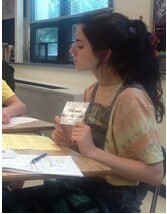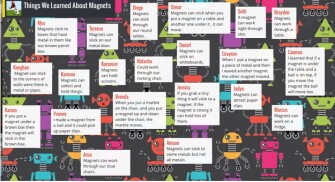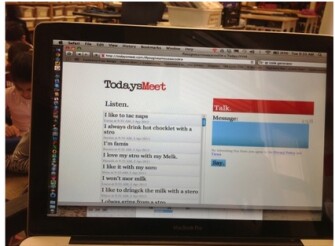(This is the first post in a two-part series)
This week’s question is:
What can we do to get all students in class participating more all the time?
This post (and the next one) functions as a Part Two to a post published last year on a similar topic. That response, Ways To Cultivate ‘Whole-Class Engagement,’ has turned-out to be an incredibly popular one.
Today, William & Pérsida Himmele, Jennifer Gonzalez and Karen Lirenman share their ideas. In addition to responses from other invited contributors, the next post in this series will include suggestions from readers. You might also consider listening to a ten-minute conversation I had with William, Pérsida and Jennifer on this topic during my BAM! Radio show.
Response From William & Pérsida Himmele
Pérsida and William Himmele are associate professors at Millersville University and William is also coordinator of Millersville’s ESL certificate program. They have each taught in a variety of environments, and have written and presented on topics including student engagement and teaching English language learners. The Himmeles are authors of the ASCD books Total Literacy Techniques: Tools to Help Students Analyze Literature and Informational Texts, Total Participation Techniques: Making Every Student and Active Learner, and The Language-Rich Classroom: A Research-Based Framework for Teaching English Language Learners:
Student engagement is more than just making sure that students are entertained with or participating in a lesson. We can have students participating and entertained with whatever it is we’re teaching, and still fail to make a lasting impact on their learning. In order for it to stick, it has to matter. It has to involve higher-order thinking. We talk about Total Participation Techniques as being those techniques that require evidence of active participation and higher-order thinking from all students at the same time. It may sound overwhelming, but with the right techniques it is not hard to do.
A really simple way to engage students in a reading using higher-order thinking is through a Total Participation Technique (TPT) called a Hold-Up. Basically, it involves students holding up a card that represents an answer to a higher order prompt. One of the most versatile hold-ups involves four cards: True, Not True, True with Modifications, and Unable to Determine. A friend of ours, Melanie Upton, teaches Language Arts to high school students. During a video-taped lesson for students’ reading of Mary Shelley’s Frankenstein, Melanie had the students read a modern day article on genetics and cloning. Students were initially asked to respond to higher-order prompts about cloning along with their rationales for one of four responses: True, Not True, True with Modifications, and Unable to Determine. Then students shared in pairs their rationales for their responses. Next, they shared responses with the whole group by holding up the card that corresponded with their response to the prompt. Melanie read the prompt and then asked students to select one of the four response cards and hold it up so that everyone could see it. It’s important to note that by the time students had shared in the whole group, they had already shared individually and in small groups. That was a key in getting all students to meaningfully contribute.

That’s what student engagement looks like. The content finally matters, and you are invested in interacting with it and in having an impact on others’ understanding of it. When we plan for evidence of active participation and higher-order thinking from all students at the same time, we’re much more likely to get meaningful student engagement. All of the students were invested, because they were required to analyze and evaluate the content on an individual level, with a peer, and then in a whole group format with the use of a Hold-Up. After processing it in these three ways, the students again read the prompts and kept or changed their original responses. Interestingly, many of the students changed their responses.

Response From Jennifer Gonzalez
Jennifer Gonzalez is a National Board Certified Teacher in Early Adolescence/English Language Arts. She taught middle school for eight years and trained pre-service teachers at the university level for four. She is editor-in-chief at Cult of Pedagogy and the author of The Teacher’s Guide to Tech. Follow her on Facebook, Twitter, and YouTube:
Our students are the most untapped resource in our classrooms: Their questions, their ideas, and the inspiration they spark in others can enrich learning for everyone. If we don’t take deliberate steps to draw out each of their voices, we’ll never know the genius we’re missing. The good news is, taking those steps can be pretty easy.
One way to increase student participation is to build short bursts of writing into your usual activities. Having students formulate their thoughts in writing before they speak gives everyone a chance to respond to the question. And the more reflective or shy students will appreciate the extra thinking time. If you use think-pair-share, have students grab a sheet of paper and jot down a sentence or two before turning and sharing their thoughts with their partner. When having whole-class discussions, instead of throwing out a question to the group and waiting for someone to raise their hand, have everyone write down a quick response first: This way, you can call on anyone, because they all wrote something down.
Another approach is to turn solitary seatwork into a social, active experience by using chat stations: Simply divide the seated activity into smaller tasks, then post those tasks around the room into separate stations. Have students rotate through the stations in pairs or groups, either checking the answers as they go or coming together as a class to review their responses. (This video shows you how it works.) This strategy gives every student a chance to engage in the work and talk through it with other students.
Keeping handy a supply of highlighters and post-it notes (or their digital equivalents) - and requiring students to use them -- can also boost participation. If you are introducing a new assignment and want students to read the requirements carefully, tell them to highlight three places where they have questions or see a detail they want to remember. Then have students share what they highlighted. When reading an article or book, tell students to place at least two post-it notes in spots where they are confused, see a word they don’t know, or have some kind of reaction. When reading time is done, call on students to discuss their post-its with a neighbor or the whole class.
Technology offers quite a few options for boosting student participation. Stick Pick is designed to help equally distribute which students you call on. Response systems like Kahoot or Socrative let you ask questions and get the whole class to respond on their own devices; if you’re short on those, Plickers lets you do the same thing with paper and one teacher device. Finally, a tool like TodaysMeet opens up an online chat room - a backchannel - where students can ask questions and make comments during a movie, a presentation, or a lab day when lots of students are likely to need help.

Response From Karen Lirenman
Karen Lirenman is an award winning grade one teacher in Surrey, British Columbia, Canada. In her classroom, she is transforming education by connecting her students with the world using Twitter, blogs and video conferencing:
Whether you’re in a one to one or a bring your own device environment, or your students have access to shared devices, there are a variety of ways to have your students simultaneously contribute to class discussions while utilizing technology. Let me explain a few.
Padlet is a web based bulletin board that allows an unlimited number of people to add information such as text, images, or links concurrently. You create a wall and share it’s unique URL As a grade one teacher I will create a QR code from the URL for quick access. Here is a sample of a padlet from my class. Each child added their information at the same time.

Google has created Google Docs, Sheets, Slides, and Drawings that can be accessed by up to 50 people at one time. The teacher creates the document, grants editing rights, and shares it via an email invite or a public link. These links are often quite long so it’s helpful to create a shorter link using bit.ly or tinyurl.com. Each child can add their ideas to the shared document.
Twitter is another tool for giving students voice. A class can utilize hashtags to direct tweets to a specific location. For example while watching a Discovery Education First Nations webinar, my students back channelled their thoughts and questions to the hashtag #discoveryfn. With younger students I would recommend each child tweet from the same class account and the teacher approve tweets before they go public.
Here are a few sample tweets from our backchannel.

If twitter is blocked in your school district Today’s Meet is another tool to try. Students 13 years or older, or with special permission from Today’s Meet, can access a room and share thoughts in 140 characters or less. With Today’s Meet you decide how long you want your room open for from 1 hour to up to one year. Students access the room via a shared URL and type their thoughts.
In the image below my students were using Today’s Meet to predict what was going to happen next in a story I was reading to them.

So if you have access to devices, even shared devices, these four websites are excellent ways to give your students a voice. And if by chance you want your discussions to include voices from other classes or other countries, share the URLs or twitter hashtags and they can join in too.
Thanks to William, Pérsida, Jennifer, and Karen for their contributions!
Please feel free to leave a comment your reactions to the topic or directly to anything that has been said in this post. As I mentioned earlier, I’ll be including ideas from readers in Part Two.
Consider contributing a question to be answered in a future post. You can send one to me at lferlazzo@epe.org.When you send it in, let me know if I can use your real name if it’s selected or if you’d prefer remaining anonymous and have a pseudonym in mind.
You can also contact me on Twitter at @Larryferlazzo.
Anyone whose question is selected for weekly column can choose one free book from a number of education publishers.
Just a reminder -- you can subscribe and receive updates from this blog via email or RSS Reader... And,if you missed any of the highlights from the first three years of blog, you can see a categorized list below. You won’t see posts from school year in those compilations, but you can review those new ones by clicking on the monthly archives link on this blog’s sidebar:
Best Ways To Begin & End The School Year
Teaching English Language Learners
Teacher & Administrator Leadership
Education Week has published a collection of posts from blog -- along with new material -- in an ebook form. It’s titled Classroom Management Q&As: Expert Strategies for Teaching.
Watch for Part Two in a few days...
